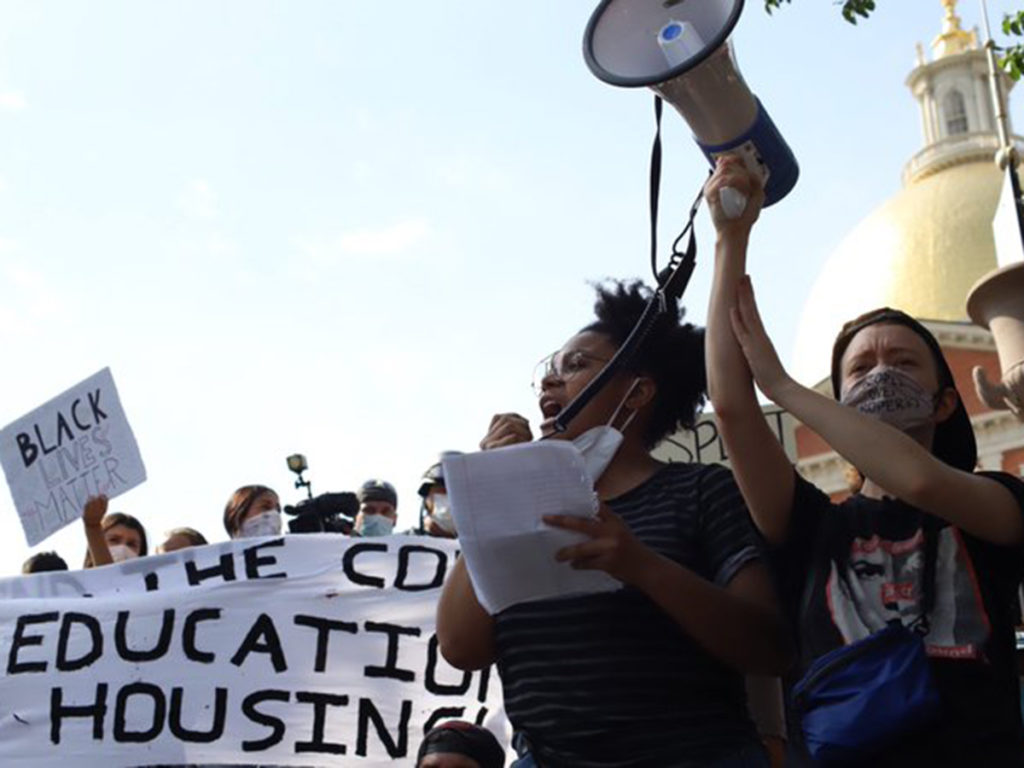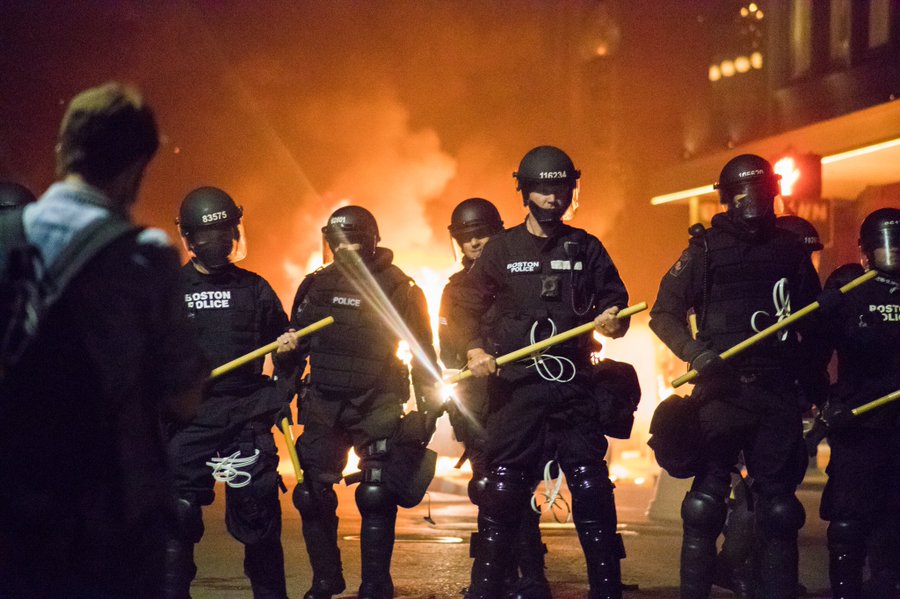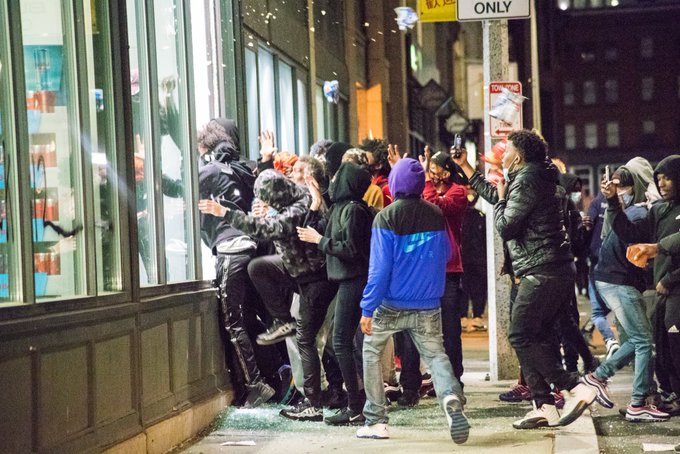Journalism Students Cover Black Lives Matter Protests

By David Ertischek ’01
Journalism student Stephanie Purifoy ‘21 delineates the May 31 protest in Boston by what happened before and after sundown.
Purifoy, digital managing editor of the Berkeley Beacon, who also spends her weekday nights as an evening Metro co-op for the Boston Globe, covered both aspects of the protests against police brutality against Black citizens and the killing of George Floyd, Breonna Taylor, and others.
“Before the sun went down, it was really powerful. The amount of people who were there, and obviously the message they were trying to spread, was just filled with emotion,” said Purifoy, who returned to Boston in May after being home in Michigan, and hustled out to the protest. “It’s really hard to not be affected by that. I felt myself getting a little emotional because you could obviously see they care so much about it. They were out there trying to spread their message.”
Purifoy’s photographs were featured in a Berkeley Beacon photo gallery.

Small and Peaceful
Down South in his hometown of Blacksburg, Virginia, Ethan McDowell ’23, saw a small, peaceful protest with a few hundred participants.
“It was really cool to see people come together in a small town in a part of Virginia that is not as well known for activism,” said McDowell, who is also the sports editor for the Beacon.
McDowell covered the June 1 protest independently. The local Fox affiliate, WFXR, saw his tweets, and reached out to him. The station’s broadcast covering the protest starred McDowell’s work.
“I think it’s important that these protests in small towns and small communities get coverage as well as the ones in Philadelphia, Los Angeles, Boston, and New York, because they are happening everywhere,” said McDowell. “Just because you don’t have 30,000 people doesn’t mean you’re not making a difference.”
McDowell added the police helped block off streets so participants could march. People were mostly peaceful, and he said police did a good job in not escalating tension, including when marchers stood outside of the police station.
Different City, Difference Scene
In Charlotte, North Carolina, Jakob Menendez ’21, witnessed what happens when tension is escalated by police. At one protest, police in riot gear corralled peaceful participants into an area, blocked them off, and fired tear gas and pepper spray. Police even got on top of a roof and shot down at people.
“One thing I keep on wondering is, what would these protests look like if the 300, 400 officers came as plainclothed police officers and marched in solidarity?” said Menendez, who’s been covering the impact of the coronavirus, as well as the protests for Charlotte Five. “You’d see a different picture being painted across America. Everything is peaceful until police start using these tactics.”
For a June 1 rally, Menendez wanted to provide more in-depth coverage of the ethos of the protestors.
“Basically, I have seen a lot of coverage nationally really missing a big element of what the protests were,” said Menendez, who will be the magazine editor for the Beacon. “It was just about the protests happening – not why are they happening? And why do people feel the need to protest?”
The result was a portrait series of nine Black protestors in the crowd, and Menendez video recorded the interviews. He wanted people to be able to show their emotions, not just read their words.
“Hearing their stories firsthand instead of just reading them was a lot more important,” said Menendez.
WHY WE PROTEST: Nine Black protesters, all from North Carolina and most from Charlotte, ranging from as young as 19 to as old as 58, told @jakobmenendez23 why they continue to show up, night after night, even if they are tired and in danger.https://t.co/RrAfObiSto
— CharlotteFive (@CharlotteFive) June 3, 2020
Menendez said he’s also witnessed animosity police have towards the media. He witnessed a reporter get hit with pepper bombs.
“Those little bombs smoke the area up. It gets in the air very quickly and spreads,” said Menendez. “If 35 of them are shot within a few-feet range, you’re going to notice it quickly. You start having trouble to breathe, you’re coughing, and you get a burning sensation in your eyes. Even for somebody who is obviously with the press, [police] seem to have no regard for that.”
Back in Boston…
Some images from the Black Lives Matter Protest happening right now in front of the state house. Look for more pictures and a story from @jacobseitz_ @BeaconUpdate @byChrisVan later pic.twitter.com/vKsxhKdcar
— Stephanie Purifoy (@steph_purifoy) May 31, 2020
Purifoy and Beacon Editor-in-Chief Chris Van Buskirk, who also works for the State House News Service, stuck together throughout the protests to be able to look after each other. They spent most of the peaceful part of the protest by the State House.
After the protest ended, organizers reminded participants to remain peaceful, and as the duo were in the area of Tremont Street, part of the crowd broke away into a side street of Downtown Crossing. They were met by a line of police officers in riot gear. Up until that point, she had only seen 10 or so officers, and they had all been behind the fence of the State House.
“People started yelling at the police, shouting at the police, and [the police] were kind of standing there,” said Purifoy, adding protestors were throwing water bottles. “I remember very clearly standing right behind someone who was yelling at a police officer and getting very up in the police officer’s face, and the police officer pulled pepper spray and started spraying everyone in the face.”
CW: This was the first time police pulled out the pepper spray in downtown crossing just a bit after 9 p.m. pic.twitter.com/j0EnFXr5VC
— Stephanie Purifoy (@steph_purifoy) June 1, 2020
For the next two to three hours, she and Van Buskirk captured and observed different groups clashing with the police. During their coverage she was indirectly hit with pepper spray. She said the camaraderie among protestors was remarkable as people came up to each other if they thought someone was hurt. Seeing that she was hurting from pepper spray, a person quickly ran up to Purifoy and gave her a bottle of shampoo, and then ran away.
“I was like, ‘What am I supposed to do with this?’ It was baby shampoo and you’re supposed to put it in your eyes [to help reduce the sting of pepper spray],” said Purifoy.

At the Walgreens by the Chinatown MBTA stop, Purifoy saw people throwing bricks and rocks at a parked car. The crowd turned their attention to the Walgreens and started tossing bricks and rocks at the store’s windows.
“That was only one of the times that I was scared for a minute… Flying bricks and flying glass… That was a moment I backed far away,” said Purifoy.
She also witnessed a Boston Police car that had been set ablaze on Tremont Street, and said it was a surreal experience. Purifoy and Van Buskirk weren’t there when the vehicle started burning, but headed towards it when they could see the flames.
“It was so weird seeing this part of town that [I] spent last three years in,” said Purifoy, who is attending the Washington, D.C. program this fall. “These are the streets you walk every day… and then sprinting away from police on them…The memories of that place have been altered a little bit.”
Categories